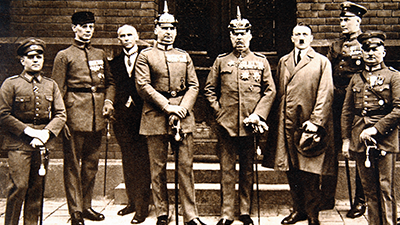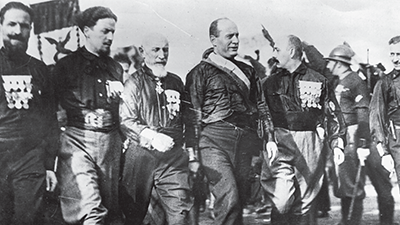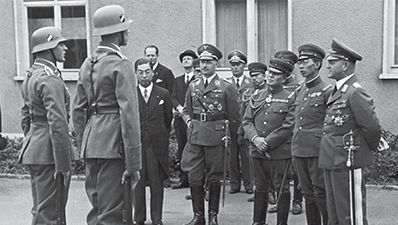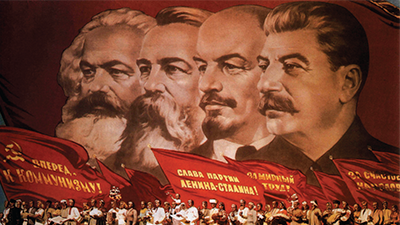Comparing Authoritarianism
Teacher Resources
Driving Question: How were authoritarian governments in the interwar period similar and different?
Not all authoritarian governments looked alike, but they had a lot in common. This lesson gives you the tools to spot patterns and challenge the idea that there’s just one version of dictatorship.
Learning Objectives:
- Use close-reading skills to identify how authoritarian leaders gained and maintained power across different interwar governments.
- Use the historical thinking practice of comparison to evaluate similarities and differences among fascist and communist regimes in the interwar period.
Vocab Terms:
- authoritarian
- collectivization
- communism
- fascism
- ideology
- militarism
- totalitarian
Opener: Comparing Authoritarianism
To teach this lesson step, refer to page 2 of the Lesson 7.4 Teaching Guide.
Check out the Vocabulary Guide to expand on this vocab-focused opener.
It wasn’t just Nazis. The interwar period elevated many different ideologies. Understanding how we define some of these terms will prepare you for this lesson.
Fascists Rise
To teach this lesson step, refer to page 3 of the Lesson 7.4 Teaching Guide.
Read Not-So-Dry January for the Interwar Years for some ideas of how to approach multiple reading at a time.
Germany, Italy, and Japan all turned to authoritarian rule during the interwar years—but they didn’t all follow the same path. To better understand the threats facing the world in the interwar years, compare how each regime rose and ruled.
-
Guiding Questions
-
Before you read
Preview the questions below, and then skim the article. Be sure to look at the section headings and any images.
While you read
Look for answers to these questions:
- How did Hitler use the Reichstag fire to his advantage?
- How did Hitler make his rise to power seem legal?
- What early steps did the Nazis take against German Jews?
- Why were the Nuremberg Laws significant?
- What did the Nazis gain by targeting Jewish people?
After you read
Respond to this question: How did the Nazi regime make extreme actions seem acceptable to ordinary people in the 1930s?
-
Guiding Questions
-
Before you read
Preview the questions below, and then skim the article. Be sure to look at the section headings and any images.
While you read
Look for answers to these questions:
- What did it take for the Fascists to defeat the Socialists in Italy?
- What were two ways fascism grew in the Po Valley?
- Why were some fascists disappointed with Mussolini early on?
- What actions did Mussolini take to strengthen his rule?
- How was Italian fascism’s view of race different from Nazi Germany’s?
After you read
Respond to this question: Why do you think Mussolini had less control over Italy than Hitler had over Germany?
-
Guiding Questions
-
Before you read
Preview the questions below, and then skim the article. Be sure to look at the section headings and any images.
While you read
Look for answers to these questions:
- How did Japan model its government after Bismarck’s Germany?
- Why was military independence from civilian leadership important for Japan’s expansion?
- What steps did Japan take that made it a fascist or authoritarian state?
- How did Japan’s economy change under government control?
After you read
Respond to this question: What actions could a society take to limit the rise of authoritarian leaders like those seen in Japan during the interwar period?
Soviet Authoritarianism
To teach this lesson step, refer to page 7 of the Lesson 7.4 Teaching Guide.
Looking to differentiate, modify or adapt this activity step? Check out our Differentiation Guide.
Explore how the Soviet Union built a new kind of community under communism. Then, compare its goals and methods to fascist regimes to see how different ideologies shaped power and belonging.
-
Guiding Questions
-
Before you read
Preview the questions below, and then skim the article. Be sure to look at the section headings and any images.
While you read
Look for answers to these questions:
- What challenges did Lenin and the Bolsheviks face early on?
- How did the Bolsheviks exercise control over politics and society?
- How did Stalin’s leadership change the way the USSR was governed?
- What effects did the Soviet command economy have on everyday life?
- In what ways was communism under Stalin similar to fascism?
After you read
Respond to this question: In what ways did the government under Stalin affect the role of communities in the USSR?
Closer: Comparing Authoritarianism
To teach this lesson step, refer to page 9 of the Lesson 7.4 Teaching Guide.
Use this quick closer to reflect on the violent and exclusionary beliefs and practices embraced by fascists.














